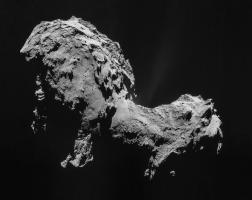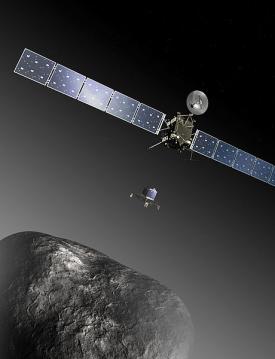Rosetta

Credit: ESA/Rosetta/NAVCAM
Rosetta was a space probe, built by ESA and launched in March 2004. Rosetta and its lander, Philae, studied the comet, 67P/Churyumov-Gerasimenko. Comets are thought to contain the stuff left over from the very start of the Solar System. The aim of the mission was to learn more about how the Solar System formed and changed over time.
Rosetta and Philae were the first space probes to:
- Orbit a comet.
- Follow a comet on its orbit around the Sun.
- Land on a comet.
- Take photographs from the surface of a comet.
Rosetta entered an orbit around comet 67P in August 2014. On 12th November 2014, Philae landed on the surface of the comet. Unfortunately, the solar-powered Philae got stuck in a dark crevice. This meant it could not make solar power as planned. However, Philae did gather scientific data for the 2 days its battery lasted.

the Philae lander to comet 67P
Credit: ESA
The mission studied jets of gas and dust from the comet. Scientific tools on board, found key ingredients for life in the comet's atmosphere: organic material and oxygen gas. The mission also studied the chemistry of the comet. It found the water vapour in the comet was different from water on Earth.
As Rosetta followed the comet further from the Sun, it could not keep making enough solar power. Eventually the space probe would freeze. ESA decided to end Rosetta's mission in September 2016. The spacecraft made a controlled crash-landing onto comet 67P.

